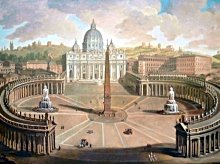CGI documentary brings Rome back to life

Friday May 12 13:35 AEST
Computer-generated imagery (CGI), until now, has been reserved for big budget Hollywood movies.
America's History Channel claims to be one of the first networks to use CGI for a television documentary - Rome: Engineering an Empire.
"In the past, CGI was really restricted to big budget movies," said Dolores Gavin, director of History Channel programming.
"But the cost of CGI animation has just dropped dramatically.
"It would be nearly impossible for us to have done the show even three years ago because the technology just wouldn't have been available to us."
Rome: Engineering an Empire charts the rise and fall of the Roman Empire from 500BC to 55AD, marking successes and failures with a focus on engineering developments.
Rome was the most powerful and advanced civilisation in the world for more than 500 years, covering the reigns of emperors Vespasian, Trajan, Hadrian, Nero and of course, Julius Caesar.
The documentary looks at various engineering feats such as the Colosseum, or the Flavian Amphitheatre as it was first known, and an early Roman shopping mall.
Instead of showing footage of Roman ruins, the documentary makers have recreated the monuments using CGI, something that differentiates the program from the many other documentaries on Rome.
CGI is the technology used by filmmakers to create scenes that would be too expensive or impossible to recreate in live action.
Various Roman aqueducts have been recreated, as has the Pantheon, Baths of Caracalla and Hadrian's Wall.
The process has caused some concern in historical circles with a number of experts believing people might mistake the recreations for exact replicas.
Others have argued that the program could not be labelled a documentary and should be referred to as fiction.
Gavin said she could understand the argument but that the CGI was used simply to illustrate the magnitude of the successes in Roman engineering.
"In the documentary world, this has been the subject of much discussion and debate," she said.
"There is a school of thought that believes that any recreations using CGI is not really considered documentary.
"But there is another school of thought that says that that is part of what we consider to be a documentary."
Gavin feels very strongly about the argument.
"CGI is one of many tools available to filmmakers to be able to tell this very compelling story about the past," she said.
"And I don't as a rule say that CGI or that reconstruction must be in every show, because there are documentaries for which those two things were not appropriate."
Rome: Engineering an Empire screened in the United States last year and premiered in Italy in April.
The program will be seen around the world this month, including on pay TV's Foxtel in Australia, and has been so successful that the History Channel has commissioned a whole series based on engineering.
They've just finished production on Egypt: Engineering and Empire with further programs to focus on the Mayan people, Khmer, Persians, Byzantines and Aztecs.
Gavin said CGI would be used in some of the upcoming programs, but not all.
"It is used as a tool and a tool that we think through and use very carefully to ensure that we can tell the story in a different way," she said.
"It really is a case by case basis, but I think it is a wonderful tool that any filmmaker should be free to use."
Director Chris Cassel will be working on the entire series.
While interested in history, Cassel is the first to admit he isn't an expert.
"We passed it past many scholars, just to ensure the accuracy of it," said Cassel.
Cassel was fascinated at how the Romans created an intricate aqueduct system to transport more than 200 million gallons of running water into Rome each day.
That is equivalent to the amount of water provided to the city of New York in 1985.
The documentary also looks at many of the secrets of Rome's architectural proficiency - the use of durable, waterproof concrete that still sustains many of the city's key structures.
It was also important to Cassell that the documentary look at some of the more interesting personal moments in Roman history.
One interesting fact to emerge was that Emperor Vespasian is credited with being the first leader to introduce pay toilets in Rome.
"I am really interested in all the juicy stuff like how Nero decapitated his wife," he said.
"The response we got from the audience in the United States showed very much that people were just as interested in the juicier parts of the story as they were in the rest."
* Rome: Engineering an Empire airs on Foxtel's History Channel
For more on ancient Rome, go to this link:
Lets-Travel-Rome.com/Ancient-Rome





0 Comments:
Post a Comment
<< Home